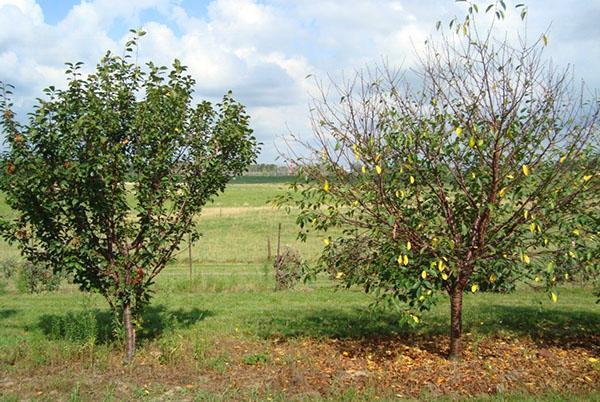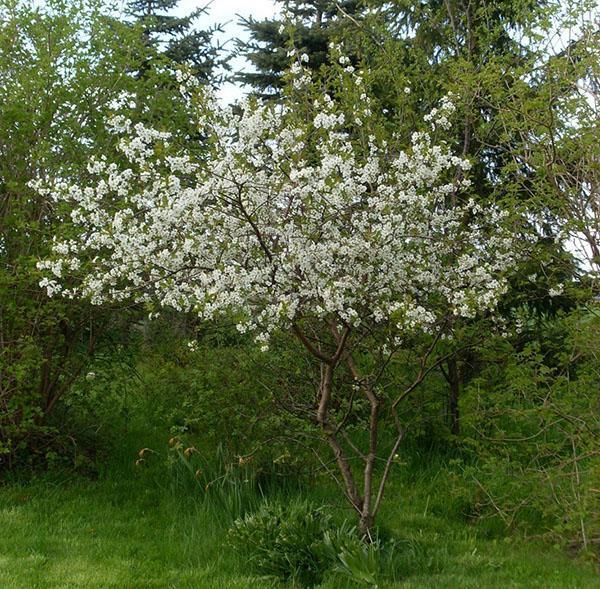Introducing Molodezhnaya cherries
 When laying a garden, gardeners have the right to choose from dozens of varieties and hybrids of fruit crops. Among the most popular is Molodezhnaya cherry, the description of the variety will help owners of personal plots to better study the plants and get the maximum possible yields from it.
When laying a garden, gardeners have the right to choose from dozens of varieties and hybrids of fruit crops. Among the most popular is Molodezhnaya cherry, the description of the variety will help owners of personal plots to better study the plants and get the maximum possible yields from it.
The domestic variety was entered in the State Register in 1993. During this relatively short period for fruit trees, the Molodezhnaya cherry shown in the photo managed to win the sincere recognition of many gardeners in the Central region, where it is zoned. What explains the popularity of the culture? What are the characteristics of the variety?
Related article: felt cherry - varieties with photos!
Description of Molodezhnaya cherry

Like Vladimirskaya cherry, the Molodezhnaya variety belongs to a bushy crop variety. Medium or low-growing plants reach a height of 2-2.5 meters, begin to bear fruit at the age of 3-4 years, and with proper care for 15-20 years, you can get 10-12 kg of juicy fresh berries from the tree. The trees have a wide-rounded or drooping crown that is not prone to excessive density and allows harvesting without difficulty without using high stairs or other devices.
The ovaries of the Molodezhnaya cherry variety are formed on one-year-old shoots, and almost all buds, except for the apical one, can be floral. Due to this feature, the trees look unusually bare after harvest. So that over time fruiting does not concentrate only on the periphery of the crown, correct agricultural technology is important, in particular autumn-spring pruning.
 According to the description of the variety, the Molodezhnaya cherry has bright green leaves with a crenate edge. On the shoots, they keep by means of short, strong petioles of greenish-brown color. The central vein is clearly visible. Medium-sized leaf plates on the outside are smooth and darker than on the back.
According to the description of the variety, the Molodezhnaya cherry has bright green leaves with a crenate edge. On the shoots, they keep by means of short, strong petioles of greenish-brown color. The central vein is clearly visible. Medium-sized leaf plates on the outside are smooth and darker than on the back.
Flowers from 1.8 to 3 cm in diameter are collected in inflorescences of 5-7 pieces. The height of the pistil is almost equal to the height of the stamens, which contributes to pollination even inside a closed bud. Petals are white, touching.
Since this cherry variety is self-fertile, even if one tree is planted, the gardener will not be left without a crop. Ovaries, especially in good weather, when there are enough pollinating insects, are formed in large quantities.
Ripening in the second half or at the end of July, the fruits of the Molodezhnaya cherry variety weigh up to 4.5 grams, which is quite good for a variety intended for central Russia. The shape of the berries is oval, the color is deep burgundy (see. chocolate variety cherry with description).
 The pulp and juice, like that of Vladimirskaya cherries, are densely colored. The stone can be easily removed from the pulp, while the juicy berry does not wrinkle and can be used in any kind of home preservation. This is also facilitated by the pleasant sweet and sour taste of ripe fruits.
The pulp and juice, like that of Vladimirskaya cherries, are densely colored. The stone can be easily removed from the pulp, while the juicy berry does not wrinkle and can be used in any kind of home preservation. This is also facilitated by the pleasant sweet and sour taste of ripe fruits.
Features of agricultural technology varieties of cherry Molodezhnaya
Cherry varieties Molodezhnaya refers to late ripening.The harvesting period begins no earlier than July 20 and lasts until the first days of August. Unlike many other varieties of this fruit crop grown in Russia, Molodezhnaya is a self-fertile plant. That is, the formation of the ovary occurs when pollen from the same tree hits the pistil. However, due to the high risk of pollen death at low, about 8-12 degrees, air temperature, it is not worthwhile to be limited to one cherry tree on the site.
To obtain stable annual yields, trees are planted at a distance of 3-4 meters from each other. In this case, bees arriving on flowering plants will cross-pollinate, providing significant assistance to both the garden and its owner.
Good neighbors for Molodezhnaya cherries will be varieties with close flowering dates, for example, Lyubskaya, Shubinka, Morozovka, Turgenevka. For self-fruitless varieties planted nearby, Molodezhnaya cherry is a pollinator that provides a harvest of sweet, healthy berries.
 One of the advantages of the described variety can be considered high, on a par with Vladimir cherry, winter hardiness. However, gardeners of the Moscow region and more northern regions need to remember that delicate buds are much more vulnerable during frosts than the trunk and skeletal branches, therefore, places for cherries are found in places that are closed from the wind, and the crown can be covered with snow in winter.
One of the advantages of the described variety can be considered high, on a par with Vladimir cherry, winter hardiness. However, gardeners of the Moscow region and more northern regions need to remember that delicate buds are much more vulnerable during frosts than the trunk and skeletal branches, therefore, places for cherries are found in places that are closed from the wind, and the crown can be covered with snow in winter.
Well-wintered trees in spring are exposed to new danger. According to the description of the cherry, the Molodezhnaya variety is not resistant to such dangerous stone fruit diseases as moniliosis and coccomycosis. Especially often trees are affected by fungal infections during a wet, prolonged spring and rainy summer.
Secrets of the yield of cherry varieties Molodezhnaya
 In order for the Molodezhnaya cherry shown in the photo to regularly please with a good harvest, the gardener needs to take care of the comfort and health of the plants. You should start by choosing a meta for planting. Cherries do not like the proximity of groundwater, heavy dense soils and cold winds, especially dangerous during flowering and ovary formation.
In order for the Molodezhnaya cherry shown in the photo to regularly please with a good harvest, the gardener needs to take care of the comfort and health of the plants. You should start by choosing a meta for planting. Cherries do not like the proximity of groundwater, heavy dense soils and cold winds, especially dangerous during flowering and ovary formation.
It is best to use places that are sheltered from the wind, but completely exposed to the sun for a cherry orchard.
Planting is carried out in early spring or autumn. One-year or two-year-old seedlings are used as planting material:
- Own-rooted plants begin to bear fruit 2–3 years after planting.
- Grafted trees, with a successful coincidence of circumstances, can please the first berries earlier.
For friendly growth and quick acclimatization, well-rotted organic matter and mineral additives are added to the planting pits. Then the trees are regularly fed, but do not forget that an excess of nitrogen leads to the massive formation of greenery, which attracts leaf-eating and sucking pests, and in the fall prevents the plant from preparing for wintering.
 In the spring, before flowering and immediately after its completion, cherry trees of the Molodezhnaya variety are treated with fungicides. This measure is necessary in the middle lane and colder regions to prevent the spread of coccomycosis and moniliosis. If necessary, crown irrigation is repeated in late autumn after pruning.
In the spring, before flowering and immediately after its completion, cherry trees of the Molodezhnaya variety are treated with fungicides. This measure is necessary in the middle lane and colder regions to prevent the spread of coccomycosis and moniliosis. If necessary, crown irrigation is repeated in late autumn after pruning.
In summer, cherry orchards are exposed to insect pests, which not only damage the ripening crop, destroy foliage and weaken plants, but also contribute to the infection of diseased plants with fungi and other types of diseases. For the destruction of pests, insecticides, means of physical and biological control, as well as folk methods are used.
It is impossible to get a good harvest without observing agricultural techniques and without carrying out preventive work.
In warm seasons, cherries must be watered and fed. Weeds are destroyed in near-trunk circles, and the soil is mulched to conserve moisture and maintain looseness of the soil. Sanitary pruning, which is carried out in the spring or fall, is equally important. All damaged, dry or weak shoots are cut and burned.The same is done with fallen leaves and uncollected fruits.